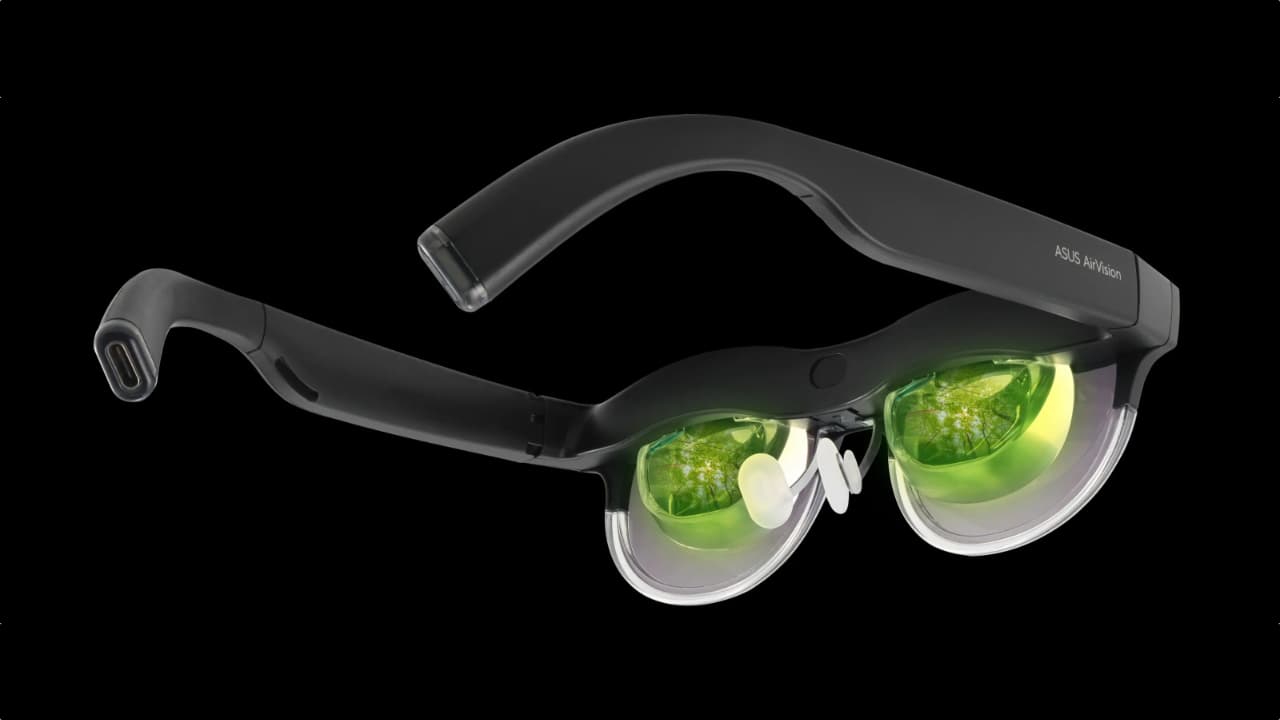
A new generation of wearables such as the ASUS AirVision M1 display glasses offer innovative features for video professionals seeking more screen real estate and multitasking capabilities.
Okay, so let me set the scene here. Ten hours previously I had got off a late flight arrival to Taiwan, a country I had never visited to see a product I had never seen. My body was telling me it was 2am back at home in the UK, but my watch was saying 10am and I was in the boardroom at ASUS HQ in Taipei City; A metropolis built for the future populated by people and companies embracing the most powerful commodities in the world right now, semi conductors and AI.
I was invited here to see a new selection of ASUS ProArt monitors and ZenScreens, that seems pretty straightforward right? However they had a surprise for me, on the table in sleek black packaging is something new, and it comes with a Product Manager to show me exactly how it works. This was to be my first step in wearable display technology for video production workflows. No amount of coffee could prepare me for this so I decided to put them on and dive right in…

The search for more screen real estate
As video creatives, we’re always looking for ways to expand our workspace and streamline workflows, right? Monitors are getting bigger, ultra-wide displays are becoming the norm, and some of us even dabble in multi-monitor setups (I know some of you have four or more in your studio set ups!).
But what if you could take that immersive, multi-window workspace and wear it on your face? ASUS is making that possible with the AirVision M1, a pair of wearable display glasses aimed at professionals who need more screen real estate without the physical footprint.
Oh, and to tackle the fruit-sized elephant in the room, they look like (kinda - more on that later) regular sunglasses, not a Stormtrooper helmet from Star Wars! They retail at $699/ €699/ £599, which can buy you a lot of monitor (the insanely popular ASUS ProArt PA279CRV 4K HDR display retails for less) OR a lot of sunglasses (about three pairs of Ray Bans by my maths).
What I found though was a surprisingly well-built, comfortable, and genuinely useful device that could change the way video editors, animators, and VFX artists approach their work.
First impressions: A wearable that feels premium

RedShark's James Richings models the M1 glasses at ASUS HQ
Let’s address the first concern most creatives might have: Do they feel like a gimmick? Absolutely not. The build quality is superb—solid yet lightweight, with a sleek, professional aesthetic that doesn’t scream ‘gadget’. Unlike the clunky AR headsets we’ve seen in the past, the AirVision M1 looks more like a stylish pair of oversized sunglasses than something out of a sci-fi movie. While I wouldn’t necessarily wear them outdoors—I’d just be too conscious of how they might appear in public with the double lens set up—they feel right at home in an indoor workspace or studio with no noticeable eye strain in the admittedly short amount of time I was wearing them.
ASUS has clearly put effort into making these comfortable for extended use. The weight distribution is well-balanced, and I didn’t experience the usual discomfort that some AR or VR headsets tend to cause.
The display: A personal studio in your vision

The Micro-OLED display is the real star here. Yes, Micro-OLED! ASUS has engineered a 1080p full-color 100-inch virtual screen that appears to float in front of your eyes, creating a personal workspace without needing a physical monitor. The image clarity is sharp, colour accuracy is impressive, and the 1100nits brightness is high enough to be usable in various lighting conditions.
I should add that it took me a minute to get the focus right, it needs calibrating a little - just like a regular display, but once you’ve got it it feels a bit like when you see something crystal clear through a pair of binoculars when before it was out of focus. As a video professional, this is crucial. Editing in an environment with poor color accuracy is a nightmare, but the AirVision M1 delivers a vibrant and accurate experience, even in a *very* bright boardroom environment. In a darker space this would be improved.
A standout feature is the multi-window support, allowing you to position and resize multiple screens within your field of view. Imagine working in Premiere Pro with your timeline on one side, a reference video on another, and maybe even a chat window open for client feedback—all without needing a multi-monitor setup. You could do rough cuts in a hotel room for sure. This opens up some exciting possibilities for multitasking and working on multiple projects or timelines simultaneously or on the move. Speaking of being on the move, the audio features are excellent. This is a big plus actually, the speakers deliver cinema like sound which was unexpected, and importantly, the M1 comes with a noise cancelling microphone making remote collaborative work a possibility.
Editing and multitasking: A game-changer for video pros?
One of the first things I considered was whether the AirVision M1 could actually improve the efficiency of a professional editing workflow. It is still a question I can’t fully answer but the potential here is huge. For example:
- Timeline expansion – Instead of constantly zooming in and out on your timeline, you could have an extended timeline spread across your field of view.
- Multitasking across projects – Editors often juggle multiple timelines and projects. With AirVision, it’s easy to have a secondary timeline running in your peripheral vision for quick access.
- Remote editing & client collaboration – With the rise of cloud-based editing, AirVision could allow for virtual collaboration where you’re reviewing footage and making edits without needing a traditional desktop setup.
Are there any drawbacks?
While I was impressed overall, there are a few things to consider. Input method and control will be a learning curve for some, not everyone will have a product manager on hand but I imagine ASUS will have some good on boarding materials for users. Using an external keyboard and mouse felt natural, but navigating floating screens still required some adaptation. Also, while the display is crisp, it’s not yet a replacement for a true color-calibrated reference monitor—so grading high-end footage still demands a proper setup.
Connectivity is another factor, they’ll need to be plugged into a power source. They only draw 2W of power so it won’t drain the battery of the device you are connected to but it is still not ideal to have to connect them physically. Again, because I would most likely to use these indoors that is less of an issue than wearing them outside. Connectivity is via USB-C and solid.
Final thoughts: Are glasses the future of editing?

For video professionals, the ASUS AirVision M1 is not just a gimmick—it’s a powerful tool with real potential. It is an important step towards redefining how we manage multiple timelines, reference materials, and workflows without being tethered to a traditional multi-monitor setup. The tech is still evolving, but the experience was smooth, the display was excellent, and the overall concept of a wearable, portable workspace is incredibly compelling - and that is from a skeptic operating on little to no sleep!
Would I use them daily? Probably not as a full-time replacement for my current editing setup, but definitely as an on-the-go solution or a secondary display for multitasking. If ASUS continues refining this technology, we could be looking at the future of mobile editing and virtual workstations for video creatives.
For now, consider these an exciting glimpse into where our industry is heading. Whether you’re an editor, VFX artist, or animator, the AirVision M1 presents a new way to work smarter, not harder. And at $699/ €699/ £595, it is a glimpse into the future at a price point that is genuinely accessible!
Tags: Post & VFX VR & AR ASUS ProArt


Comments